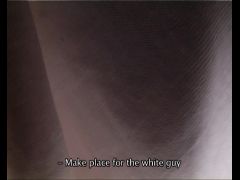Vincent Meessen
© the artist(s) & producer(s)
Vincent Meessen
© the artist(s) & producer(s)
Vincent Meessen
© the artist(s) & producer(s)
Vincent Meessen
© the artist(s) & producer(s)
Manivelle (Ouagadougou) (Produced in association with)
John Pirard (Editing)
Marc De Backer (Images)
more...
English UK (subtitled)
In this video bearing the programmatic title ‘The Intruder’, we see the artist—clad head to toe in an outfit fashioned of white cotton blossoms—strolling along the bustling streets of Ouagadougou, Burkina Faso. The camera, which does not long remain undetected (and unexposed), accompanies the performer while simultaneously recording the reactions of the observers.
In its ostentatious otherness, the white figure becomes the object of attraction and wonder, aggression and ridicule, so ultimately an invitation to the Burkinese public to freely associate and act out their readings of being "white" in this specific situation, which cluster around motifs such as the “white” as tautology and paradox: the white performer hiding behind a white mask and yet recognized as white anyways (“Is he white?” – “Yes, for sure he’s white.”); the “white” as imposter: the white performer concealing himself behind a mask of cotton, the only noteworthy natural resource in Burkina Faso (“white gold”), thus behind a “stolen” mask, and recognized for precisely that reason as white (“the white mask,” “Is that our traditional treasure that he’s wearing like that?”); the “white” as decal: the clothing is interpreted as self-evident form and as such can be turned against its wearer (compare the designations “Osama bin Laden” and “Santa Claus” in allusion to the thick beard of the mask); the “white” as aggressor: this interpretation is primarily directed toward the camera as companion to the performer, capturing not only him but also (or especially?) his observers in the image. The “white” as trespasser is both subject and object of observation, interpretation, and evaluation. He is, from the outset, perceived as image prone to being, at will, appropriated, discarded, or overlaid with new meanings. (Katrin Mundt)






